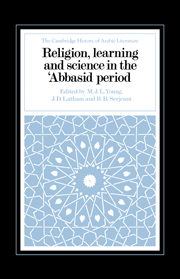Book contents
- Frontmatter
- Epigraph
- Contents
- List of plates
- Editorial preface
- List of abbreviations
- Map Literary, political and religious centres in the ʿAbbasid period
- 1 Sunnī theology
- 2 Shīʿī theological literature
- 3 Ibāḍī theological literature
- 4 Quranic exegesis
- 5 The prose literature of Ṣufism
- 6 Philosophical literature
- 7 Arabic lexicography
- 8 Arabic grammar
- 9 Islamic legal literature
- 10 Administrative literature
- 11 Arabic biographical writing
- 12 History and historians
- 13 Faṭimid history and historians
- 14 Mathematics and applied science
- 15 Astronomy
- 16 Astrology
- 17 Geographical and navigational literature
- 18 The literature of Arabic alchemy
- 19 Arabic medical literature
- 20 Al-Kindī
- 21 Al-Rāzī
- 22 Al-Fārābī
- 23 Ibn Sīnā
- 24 Al-Bīrūnī and the sciences of his time
- 25 Al-Ghazālī
- 26 Christian Arabic literature in the ʿAbbasid period
- 27 Judaeo-Arabic literature
- 28 The translation of Greek materials into Arabic
- 29 Didactic verse
- Glossary
- Bibliography
- Index
11 - Arabic biographical writing
Published online by Cambridge University Press: 05 July 2014
- Frontmatter
- Epigraph
- Contents
- List of plates
- Editorial preface
- List of abbreviations
- Map Literary, political and religious centres in the ʿAbbasid period
- 1 Sunnī theology
- 2 Shīʿī theological literature
- 3 Ibāḍī theological literature
- 4 Quranic exegesis
- 5 The prose literature of Ṣufism
- 6 Philosophical literature
- 7 Arabic lexicography
- 8 Arabic grammar
- 9 Islamic legal literature
- 10 Administrative literature
- 11 Arabic biographical writing
- 12 History and historians
- 13 Faṭimid history and historians
- 14 Mathematics and applied science
- 15 Astronomy
- 16 Astrology
- 17 Geographical and navigational literature
- 18 The literature of Arabic alchemy
- 19 Arabic medical literature
- 20 Al-Kindī
- 21 Al-Rāzī
- 22 Al-Fārābī
- 23 Ibn Sīnā
- 24 Al-Bīrūnī and the sciences of his time
- 25 Al-Ghazālī
- 26 Christian Arabic literature in the ʿAbbasid period
- 27 Judaeo-Arabic literature
- 28 The translation of Greek materials into Arabic
- 29 Didactic verse
- Glossary
- Bibliography
- Index
Summary
Biography is one of the most extensive areas of Arabic literature. Its earliest, and characteristic form, is the biographical dictionary, although biographical writing early developed a variety of other forms.
Arabic has no single term for biography. The most widely used terms are sīrah (pl. siyar) and tarjamah (pl. tarājim). The use of tarjamah tends to be restricted to shorter biographical notices, while sīrah usually refers to biographies of substantial length. The term sīrah was first used in literature for the biography of the Prophet Muḥammad, but this did not preclude its use for the biographies of less eminent figures. In both modern and medieval Arabic sīrah may also be found in the titles of works which are not strictly biographies at all, such as the traditional story Sīrat ʿAntar and Muḥammad al-Maṭwī's history of the city of al-Qayrawān entitled Sīrat al-Qayrawān. A less common term for biography is taʿrīf Qit. “definition”), which makes its appearance in literary usage after the end of the Abbasid period. In addition there are a number of terms which are used for laudatory biography or hagiography. The most widely used of these is manāqib (virtues, feats, exploits), a word which frequently appears in the titles of biographies which are intended to present a portrait of a morally admirable person, together with a recital of his outstanding actions and achievements. This kind of laudatory biography early took on the character of hagiography.
- Type
- Chapter
- Information
- Religion, Learning and Science in the 'Abbasid Period , pp. 168 - 187Publisher: Cambridge University PressPrint publication year: 1990
- 3
- Cited by

